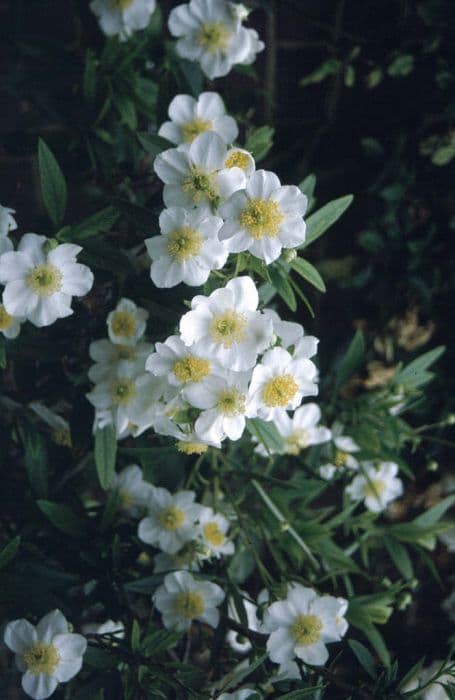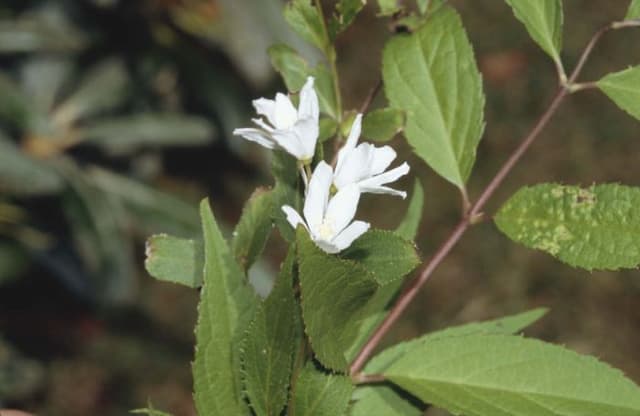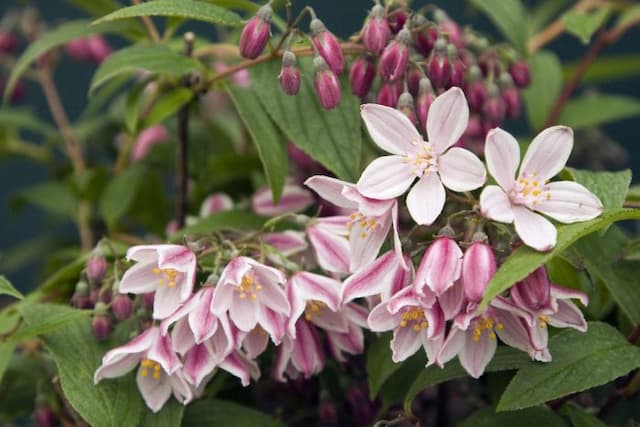Bigleaf Hydrangea Hydrangea macrophylla 'Madame Emile Mouillère' (H)

ABOUT
The Hydrangea, specifically the 'Madame Emile Mouillère' variety, is a strikingly beautiful shrub that boasts large, rounded flower heads known as mopheads. These luxurious blooms are predominantly white but can sometimes carry a hint of pink or blue depending on the soil acidity. The large flowers create a dense, opulent texture that appears as though covered in a thick layer of snow or cotton. The petals are delicate and have a gentle, velvety feel with a broad, rounded shape that gives the plant a lush, full-bodied appearance. The leaves of this variety of Hydrangea are broad, ovate, and have a rich green color that provides a stark, elegant contrast against the purity of the white blooms. The foliage is shiny and has a leathery texture, making it an excellent backdrop for the flowers. A network of sturdy stems supports the heavy blooms and foliage. These stems are typically thick and woody, providing a robust scaffold for the plant's ornate display. This Hydrangea variety presents its blooms from early to late summer, often continuing to offer visual interest into the fall. The flowers may age to a vintage cream or beige tone, adding a touch of antique charm to the plant's display as the season progresses. The plant's lush, rounded form makes it a popular choice for gardeners who wish to add a touch of elegance and fullness to their garden spaces. It is particularly favored for borders, as a focal point in landscape designs, or even as a cut flower for indoor arrangements, thanks to its appealing and, at times, almost ethereal aesthetic.
About this plant
 Names
NamesFamily
Hydrangeaceae.
Synonyms
French Hydrangea, Bigleaf Hydrangea, Mophead Hydrangea, Lacecap Hydrangea, Hortensia.
Common names
Hydrangea macrophylla 'Madame Emile Mouillère'.
 Toxicity
ToxicityTo humans
Hydrangea, the common name for Hydrangea macrophylla 'Madame Emile Mouillère', has parts that contain cyanogenic glycosides, which can release hydrogen cyanide gas when chewed or digested. However, poisoning in humans is rare as a significant amount of plant material would have to be consumed to cause a toxic reaction. If ingested, it could potentially lead to symptoms such as nausea, vomiting, and diarrhea. In severe cases, it could cause dizziness, a rapid pulse, or even more serious symptoms due to cyanide toxicity, but such extreme reactions are uncommon.
To pets
Hydrangea, also known for pets by the same common name, is toxic to animals. It contains cyanogenic glycosides, particularly in its leaves and flower buds, which can release hydrogen cyanide when chewed or digested. If pets ingest hydrangea, they may exhibit symptoms such as vomiting, diarrhea, depression, and lethargy. In severe cases, the ingestion of large amounts of the plant could lead to more serious toxic effects, possibly resulting in increased heart rate and respiratory rate, as well as cyanide poisoning, which could be life-threatening if not treated promptly by a veterinarian.
 Characteristics
CharacteristicsLife cycle
Perennials
Foliage type
Deciduous
Color of leaves
Green
Flower color
White
Height
4-6 feet (1.2-1.8 meters)
Spread
4-6 feet (1.2-1.8 meters)
Plant type
Shrub
Hardiness zones
6
Native area
Japan
Benefits
 General Benefits
General Benefits- Aesthetic Appeal: Hydrangeas are popular for their large, showy flower heads that can add significant visual impact to gardens and landscapes.
- Variety of Colors: The blooms of this hydrangea can change color based on the soil pH, providing a range of color options from pink to blue to purple.
- Long Blooming Period: Hydrangeas generally have a long flowering period, often lasting from early summer into fall, providing lasting color in the garden.
- Shade Tolerance: This hydrangea can tolerate and thrive in partial shade, making it a versatile plant for different garden aspects.
- Attracts Pollinators: The flowers can attract bees and butterflies, contributing to the health of the local ecosystem by supporting pollinators.
- Seasonal Interest: Many hydrangeas have attractive foliage and can contribute interest to the garden even when not in bloom, especially in the fall when leaves may change color.
- Ease of Cultivation: Hydrangeas are generally easy to grow and maintain, making them suitable for gardeners of varying skill levels.
- Versatility in Landscaping: They can be used in a variety of landscaping designs, including as specimen plants, in borders, or as part of mass plantings.
- Cut Flowers: Hydrangea flowers are excellent for cutting and arranging in vases, holding their shape and color well when cut.
- Drought Tolerance: Once established, some hydrangeas can exhibit tolerance to dry conditions, requiring less frequent watering.
 Medical Properties
Medical PropertiesThis plant is not used for medical purposes.
 Air-purifying Qualities
Air-purifying QualitiesThis plant is not specifically known for air purifying qualities.
 Other Uses
Other Uses- Craft Dye: The blossoms of the Hydrangea can be used to create natural dyes for fabrics, with the color varying depending on the pH of the water used.
- Landscape Design: Hydrangeas are often used in garden designs for their lush foliage and large, colorful blooms, providing a visual impact and structure to garden beds.
- Potted Plants: Hydrangeas can be grown in containers and used to decorate patios, balconies, or as indoor ornamental plants given proper care.
- Dried Flower Arrangements: The blooms dry beautifully and retain their shape and color, making them ideal for long-lasting floral displays.
- Photography: The impressive blooms and variations in color make hydrangeas a popular subject for photographers, especially in macro photography.
- Wedding Decor: Due to their full and vibrant blooms, they are often used in wedding bouquets, centerpieces, and venue decorations.
- Theme Gardens: Because Hydrangeas can change color based on soil pH, they can be used in educational theme gardens to demonstrate soil chemistry to visitors.
- Bird Habitat: The dense foliage can provide shelter for birds, while the flowerheads can offer nesting material for small garden birds.
- Art Subjects: Their distinctive look has made hydrangeas a favorite subject for artists, from traditional painting to modern digital art pieces.
- Seasonal Celebrations: In some cultures, the blooming of hydrangeas is associated with certain seasons or festivals and used accordingly in festivities.
Interesting Facts
 Feng Shui
Feng ShuiHydrangeas can be used in Feng Shui to attract abundance, prosperity, and to represent gratitude. Place the hydrangea in the east side of your garden to enhance family harmony and health or in the southeast to attract wealth and abundance.
 Zodiac Sign Compitability
Zodiac Sign CompitabilityThe hydrangea is not used in astrology practice.
 Plant Symbolism
Plant Symbolism- Gratitude and Apology: Hydrangeas often symbolize heartfelt emotions, including expressing gratitude to others, or an apology for a misunderstanding, possibly due to the plant's generous rounded shape symbolizing abundance.
- Understanding: The hydrangea is also associated with seeking or achieving a deeper understanding of someone, particularly in Japanese culture, where it is connected to the notion of apology and gratitude.
- Heartlessness and Frigidity: In contrast, the hydrangea can sometimes be symbolic of heartlessness or frigidity, stemming from the Victorian language of flowers where it was considered to represent disinterest or a lack of empathy.
- Perseverance: This plant can also signify perseverance, given its ability to bloom through a range of conditions and revive after wilting, it can represent toughness or recovery.
- Beauty: The lavish and full heads of the hydrangea flowers suggest an abundance of beauty, related to its lush and attractive blooms.
 Water
WaterFor the Bigleaf Hydrangea, thorough watering is crucial, particularly during hot or dry periods. Water the plant deeply about three times a week to ensure the soil remains moist but not waterlogged. Each watering session should aim for about one gallon of water, allowing the moisture to penetrate the soil deeply and reach the roots. Adjust the watering frequency to accommodate rainfall, and reduce watering in the winter when the plant is dormant.
 Light
LightBigleaf Hydrangeas prefer bright, indirect sunlight or partial shade. A spot that gets morning sunlight and afternoon shade is ideal for this plant to thrive without the leaves getting scorched by the harsh midday sun. Avoid placing it in deep shade or full sun, as both conditions can harm the plant and inhibit its growth and flowering.
 Temperature
TemperatureBigleaf Hydrangeas flourish in a range of 50°F to 80°F, which is an ideal temperature for robust growth. They can survive minimum temperatures down to 20°F, but will struggle if the temperature drops any lower. During the growing season, maintaining a stable environment within the ideal temperature range will encourage healthy blooms and plant vitality.
 Pruning
PruningPrune Bigleaf Hydrangeas to remove dead wood and to shape the plant, usually done in late winter or early spring before new growth starts. These hydrangeas bloom on old wood, so it's important to avoid cutting off stems that will bear the year's blooms. Light pruning to remove dead flowers and any weak or crossing branches can be done after flowering to maintain the plant's appearance.
 Cleaning
CleaningAs needed
 Soil
SoilThe Bigleaf hydrangea prefers well-draining, rich loamy soil with a pH of around 5.5 for blue flowers or closer to 6.5 for pink flowers. Incorporate organic matter like compost into the planting mix to help retain moisture and provide nutrients.
 Repotting
RepottingBigleaf hydrangeas should be repotted every 2 to 3 years, or once they outgrow their current container, to ensure continued health and optimal growth.
 Humidity & Misting
Humidity & MistingBigleaf hydrangeas thrive best with high humidity levels, ideally above 60%, which mimics their native environment in Japan.
 Suitable locations
Suitable locationsIndoor
Keep in bright, indirect light with high humidity.
Outdoor
Plant in morning sun, afternoon shade, well-draining soil.
Hardiness zone
6-9 USDA
 Life cycle
Life cycleThe life of the Hydrangea macrophylla 'Madame Emile Mouillère', also known as the Bigleaf Hydrangea, begins with seed germination, which can vary in time depending on environmental conditions. Following germination, the seedling emerges and gradually develops into a young plant with characteristic broad green leaves. Over time, the plant enters the vegetative stage, maturing and expanding through leaf growth and branch development. During the spring and summer, it enters the reproductive stage, producing large, showy clusters of white flowers that can change color based on soil pH; these blooms last well into fall. After flowering, the plant sets seeds that can be dispersed to begin a new generation. As a perennial, the hydrangea then undergoes seasonal dieback of the aerial parts during the winter months, conserving energy in its root system to re-sprout in the spring.
 Propogation
PropogationPropogation time
Spring-Early Summer
The most popular method of propagation for Hydrangea macrophylla 'Madame Emile Mouillère', commonly known as the mophead hydrangea, is through softwood cuttings. This technique is generally carried out in late spring or early summer when the plant's new growth is still tender and green. To propagate, gardeners select a healthy stem that has not flowered and cut a 4 to 6-inch (approximately 10 to 15 cm) length just below a leaf node. The lower leaves are then removed, and the cut end may be dipped in rooting hormone to encourage root development. The cutting is planted in a mix of potting soil and perlite, kept moist, and placed in indirect light until roots have established, after which it can be transplanted outdoors.







![Hydrangea [Strong Annabelle]](/_next/image?url=https%3A%2F%2Fplants-admin.emdemapps.com%2Fimages%2Fplants%2F%2Fimages%2F604b54db37d34.png&w=640&q=75)

